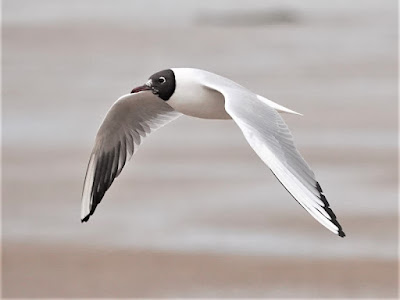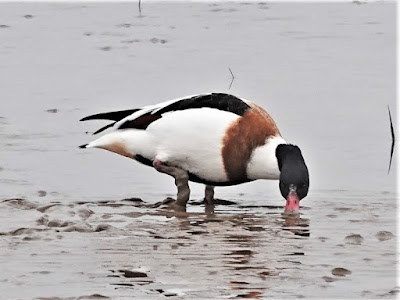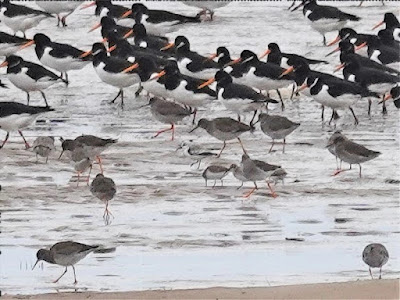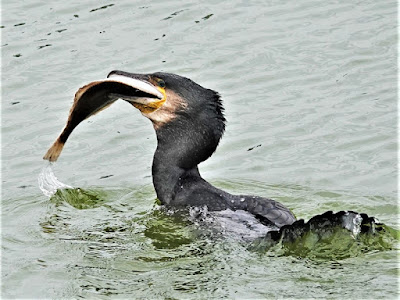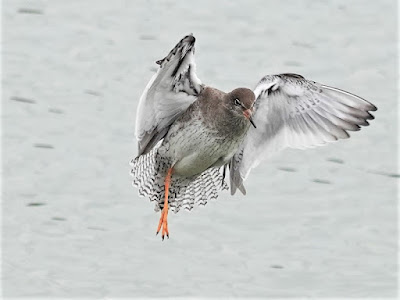Starting at Meols some three hours ahead of high tide found this mixture of Dunlin (front) and Knot feeding in a channel close to the footpath that runs all the way along the foreshore here.
Handy size comparison: a Knot leads a Dunlin.
A very common wader on the mud is Redshank.
A surprise was finding this wader. At the time I misidentified it as a Bar-tailed Godwit which is regular in small numbers here. But it is a Black-tailed Godwit which is only usually found much further up the estuary and on fresher water. Its identity is confirmed by the length of the leg above the 'knee' (anatomically really the ankle) making the bird taller. And also the straight bill which is slightly upcurved on Bar-tailed Godwit.
Size comparison with a Knot. That long bill can reach deep in to the mud.
That is a strange way to fly!
A complaining adult Lesser Black-backed Gull. By this stage of the year the legs are unmistakeably yellow.
Another fine-looking adult passes by.
Mud, mud....
....glorious mud.
Two pesky Peregrines, likely young females on size, arrived in the area and promptly caused panic amongst the waders. These are all (I think!) Knots and Dunlins going hither...
...and thither.
And they manage this without Air Traffic Control!
A "must see" sight here is the "March of the Oystercatchers" as they walk en masse ahead of the fast rising tide and try to avoid getting their bellies wet.. Not so spectacular this time partly because of the pesky Peregrines and also because many have departed to their, often inland, breeding sites. (A pair tried to breed on the old Celestica site north of the Balancing Lake about 10 years ago)
With the waders mainly chased away it was off to another location.
- - - - - - - - - - - - - - - - - - - - - - - - - - - - - - - - -
After looking at waders being brought close to shore by the rising tide it was off to New Brighton. Between the shopping complex that includes a large Morrisons (and car park) and Fort Perch (and the disused lighthouse that guards the entrance to the River Mersey) is a small Marine Lake. The lake has pontoons used to launch canoes etc. during the summer but which are used as a high tide roost during winter.
Even before the pontoons hove in to sight this Cormorant emerged from the lake with its breakfast, lunch and dinner combined. I suspect the fish is a Dab Limanda limanda.
Down the hatch?
Too large perhaps?
Let's try at an angle.
Open wide and try sideways.
Doesn't seem to fit.
It certainly won't fit like that. The Cormorant seems to have almost dislocated its jaw.
It manage to climb out on the pontoon, scattering Redshank and Turnstones.
And somehow managed to swallow it.
Just the tail to go. Whew!
After all the hassle a Purple Sandpiper finds a quiet spot for a snooze. The 'purple' is mainly fanciful unless you go to its Arctic Alaska breeding grounds where for a few weeks the plumage does indeed gloss purple,
A clearer view of the first year Herring Gull with another one-legged Dunlin flying by.
You caused a lot of fuss.
A one-legged Redshank repositions in to the throng.
Now two of them, the first looks as if it might do a nose-dive.
One inbound head-on, tail spread and yet again showing only one leg, as does the standing Redshank.
And another. They paint their toe-nails black!
Er? Three Redshank: four legs. Go figure. The front bird is coming in to breeding plumage
(Ed Wilson)







